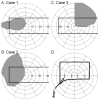Hazard Detection by Drivers with Paracentral Homonymous Field Loss: A Small Case Series
- PMID: 24501685
- PMCID: PMC3910664
Hazard Detection by Drivers with Paracentral Homonymous Field Loss: A Small Case Series
Abstract
Introduction: Stroke frequently causes homonymous visual field loss. We previously found in a driving simulator that patients with complete homonymous hemianopia had difficulty detecting potential hazards on the side of the field loss. Here we measured the effects of limited paracentral homonymous field loss on detection performance.
Methods: Three patients with paracentral homonymous scotomas, yet meeting vision requirements for driving in the United States, performed a pedestrian detection task while driving in a simulator. Pedestrians appeared in a variety of potentially hazardous situations on both sides of the road. Three age- and gender-matched control participants with normal vision participated for comparison purposes.
Results: Pedestrians appearing in the scotomatous side of the visual field were less likely to be detected, and when they were, reaction times were longer, frequently too late to respond safely.
Conclusions: Although legally permitted to drive in the U.S.A., and possibly in other countries, patients with paracentral homonymous field loss may have impaired hazard detection and may benefit from education about their deficit and a fitness-to-drive evaluation.
Keywords: Low vision; driver licensing; hemianopsia; quadranopia; quadranopsia; quadrantanopia; sectoranopia.
Figures




References
-
- Gilhotra JS, Mitchell P, Healey PR, Cumming RG, Currie J. Homonymous visual field defects and stroke in an older population. Stroke. 2002;33:2417–2420. - PubMed
-
- Zhang X, Kedar S, Lynn MJ, Newman NJ, Biousse V. Homonymous hemianopias: clinical-anatomic correlations in 904 cases. Neurology. 2006;66:906–910. - PubMed
-
- Driver and Vehicle Licensing Agency S. [accessed Nov. 4, 2011];Drivers_Medical_Group, For Medical Practitioners At a glance Guide to the current Medical Standards of Fitness to Drive. 2011 Feb; http://www.dft.gov.uk/dvla/medical/ataglance.aspx.
-
- Yazdan-Ashoori P, ten-Hove M. Vision and Driving: Canada. J Neuroophthalmol. 2010;30:177–185. - PubMed
Grants and funding
LinkOut - more resources
Full Text Sources
